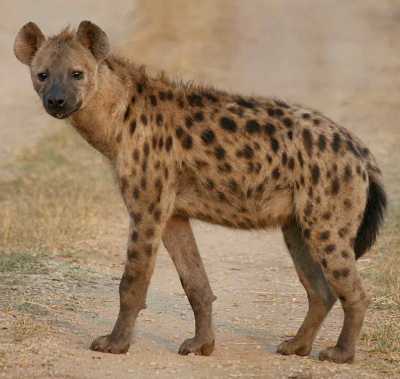 SKC Films Library SKC Films Library |
| SKC Films Library >> Science >> Zoology >> Mammals >> Order Carnivora >> Family Hyaenidae |
| Spotted Hyena Crocuta crocuta [krO kU' tuh krO kU' tuh] Description The second largest carnivore in Africa after the lion, the spotted hyena is 3-5 feet long from head to tail, 2.4-2.8 feet tall at the shoulder, and weighs 99-176 pounds; females are larger than males. The coarse, wooly coat is sandy, yellowish or gray in color with black or dark brown spots that are darkest in younger animals and can be almost completely absent in very old animals. The 10-14-inch tail ends in a bushy black tip.
Like other hyenas, the spotted hyena's forelegs are longer than its hind legs. It has four digits on each foot, with short, non-retractable claws and broad toe pads. Strongly built, it has a massive neck and large head like other hyenas, but its ears are rounded while those of other hyenas are pointed. The massive neck supports strong jaw muscles that allow the spotted hyena to crush heavy bones with ease. The reproductive organs of both sexes are very similar in exterior appearance, making it difficult to distinguish between males and females from any kind of distance. Like most other carnivores, the spotted hyena has good hearing and sharp night vision. Distribution and Habitat Spotted hyenas are found throughout much of sub-Saharan Africa except for the tropical rainforest of western and central Africa and areas with extreme desert conditions, with the greatest densities in the Serengeti ecosystem of Tanzania and Kenya. They inhabit many types of open, dry habitat, including semi-desert, savannah, acacia bush, and mountainous forest.
Habits and Behaviors Spotted hyenas live in clans numbering up to 80 members, with clan size being determined primarily by the abundance (or lack) of prey. Each clan has a strict hierarchical structure, with females at the top and males at the bottom; even the lowest ranking female is dominant to the highest ranking male. Females generally inherit their clan rank from their mothers (the daughter ranking just under the mother until the mother dies) and hold their rank for life, while males can move up in the hierarchy as older higher-ranking males die. Males spend a long time developing relationships with females in the clan. They follow females for periods of days or weeks and eventually gain favor with the females through this behavior. Females tend to stay in their natal clan, while males emigrate upon reaching sexual maturity. Although spotted hyaenas live in clans, the members of a clan are only observed all together in three circumstances -- at kills, when defending the territory, and at a communal den. More often than not, the clan members forage alone or in small groups. Higher ranking females have been shown to associate more with kin than low-ranking females, and low-ranking females preferentially associate with higher ranking females. Although each clan will defend a home territory (through vocal displays and scent marking), clans often cross each other's territory when following herds of prey animals. Aggression is rare between resident clan members and commuting individual hyaenas. Non-resident hyaenas typically defer to resident clan members at a kill, but this situation may also result in physical aggression. Spotted hyenas are well known for the wide variety of vocal communication they use. Groans and soft squeals are emitted during hyena greetings. A whoop is used as a contact call, and there is a fast whoop that is used by excited hyenas at a kill. Males give the fast whoop more often than females but are generally ignored; female calls generally elicit much more of a reaction. Finally, a lowing call is used by impatient hyenas who are kept waiting at a kill. Several calls are related to aggression, including grunting, giggling, growling, yelling, and a rattling growl. These calls are given in various aggressive interactions with clan members, other clans, or other species. The giggling that is the trademark "laughing" call of the hyaena is associated with fear or excitement and is often given when an individual is being chased. Spotted hyenas can trot at 6 mph for long distances without tiring and are good swimmers. Reproduction Spotted hyenas are promiscuous and will mate at any time of the year. All females can produce litters, but alpha females tend to begin reproducing at an earlier age, have shorter interbirth intervals, and increased survival of offspring, all of which traits pass on directly to female offspring. The mechanism responsible for the increased fitness of high ranking females is probably the increased access to food that alpha females receive. In addition, high ranking female hyenas seem to preferentially give birth to sons. Infanticide has been witnessed several times in the wild both by hyenas from neighboring clans and also by females from the same clan. A male will approach any female in heat, but will retreat immediately if she shows any aggression and/or unwillingness to mate. Gestation takes about 4 months, after which 1-4 precocious cubs (with twins being the most common litter size) are born. If siblings are the same sex, they begin fighting violently soon after birth, which usually results in the death of one of the two. Two to six weeks after birth, the mother transports her surviving young from the burrow in which they were born, often an abandoned aardvark, warthog or bat-eared fox burrow, to a communal den. Females are very protective of their young and do not tolerate other hyenas, especially males, around them at first. Mothers also intervene on behalf of their daughters in antagonistic encounters and form coalitions with them to secure the place of the daughters in the dominance hierarchy immediately below that of the mother. Males have not been reported to have a role in parental care. Although communal denning is common, no communal care of young occurs except in very rare circumstances (usually associated with extremely difficult environmental conditions). The major source of food for the young for the first 12-14 months is milk from the mother. The milk of the spotted hyena has the highest protein content (mean 14.9%) recorded for any terrestrial carnivore, a fat content (mean 14.1%) exceeded only by that of palaearctic bears and the sea otter, and a higher gross energy density than the milk of most terrestrial carnivores. Although a spotted hyena cub can eat meat within a few months of birth, it will not be weanes until it is 14-18 months old. Female spotted hyenas become sexually mature at 21-48 months, males at 36-48 months. The average lifespan of the spotted hyena in the wild is about 20 years. Diet Although commonly portrayed as a scavenger, the spotted hyena is actually a very skilled hunter, with up to 95% of its diet coming from hunts. An opportunistic hunter, the spotted hyena is capable of taking down almost any herbivorous mammal, including wildebeests, zebras, gazelles, and even buffalo, as well as young hippos and giraffes. Although spotted hyenas typically hunt alone or in small parties, large hunting parties have been observed. Once a hyena has "locked in" on its prey, it can and will chase it at speeds of up to 37 mph for up to 5 miles. Despite its hunting skill, the spotted hyena will not pass up any opportunity to scavenge another predator's kill, and groups of hyenas have been observed actually "convincing" lions to give up their kills. Whether its meal was killed or scavenged, the spotted hyena tends to consume it very rapidly; a single hyena can consume an entire gazelle fawn in less than two minutes. The spotted hyena's robust digestive system allows it to digest things other carnivores cannot, such as skin and bone; it cannot, however, digest horn. Its digestive system also allows it to consume as much as one-third of its body weight at one meal without slowing it down. Scientific Classification phylum Chordata SOURCES |
| SKC Films Library >> Science >> Zoology >> Mammals >> Order Carnivora
>> Family
Hyaenidae This page was last updated on June 10, 2017. |

